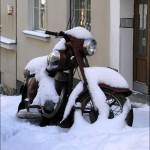Winterizing Your Motorcycle for the Season

Now that the year is drawing to a close, your time spent on the motorcycle is limited. You’ll be putting it in storage soon. These proper winterizing techniques will allow you to store your motorcycle safely, so it’s ready for action again next spring.
- Change the oil: It may not be due for an oil change yet, but your motorcycle’s oil can break down with time, and the byproducts in used oil can hurt the engine while it sits. Changing the oil will ensure that your bike is ready to go right away when spring comes again. Use winter-grade oil for maximum protection. If you’ve never changed the oil in your motorcycle before, this online tutorial may help.
- Lubricate: Lubricating the moving parts prevents the metal from rusting over the course of the winter. When applying the lubricant, pay close attention to the chain, cables and all pivot points.
- Wash your bike: Be very thorough and dry it very well. Washing the motorcycle will prevent anything that sits on your bike’s metallic surfaces or paint job from eating away at the surface. Drying it thoroughly will prevent the metal from rusting over the winter. Note that the bike must be absolutely dry if you cover it with a tarp for the winter.
- Protect the cylinders: Spray the cylinders inside with fogging oil if you plan to let the bike sit for more than half a year.
- Add fuel stabilizer: Adding fuel stabilizer to your motorcycle’s fuel supply prevents the fuel from gumming up and clogging the lines with time. After adding the stabilizer, let the bike run for 10 minutes. If you’re going to let the bike sit for more than 4 months, it’s a good idea to drain the carbs too.
- Remove the battery: Your motorcycles battery drains just a tiny bit with every minute it’s hooked up to your motorcycle. Left hooked up to your motorcycle all winter long, the battery could die. To protect the battery from draining entirely, remove the battery, or hook up a battery tender to keep the battery from draining.
- Check the tire inflation: Pump up the tires to their maximum inflation. Mark your calendar to check the tire pressure throughout the winter, to prevent the tires from deflating during its time in storage.
- Stuff the exhaust pipe with a plastic bag and an oil soaked rag: This will prevent moisture and animals from invading the muffler.
Now that your motorcycle has been thoroughly prepped, it’s time to store it somewhere dry and cool, away from a window, properly protected from dust. If possible, use a motorcycle cover to protect your motorcycle instead of a tarp. Tarps can lock in moisture and cause your bike to rust. Place the motorcycle on a stand that keeps the tires from touching the ground, or put a piece of wood beneath each tire to prevent the tire from touching the freezing ground.
With this done, your motorcycle should be ready to roll out of the garage and ride when winter is over. At the law offices of Beier Law, we hope that your motorcycle is well protected this winter, and that next spring you’re able to ride it once again. Should an accident occur, contact a personal injury attorney with a track record of success.

